Implementation > Inspiration: Why Execution Outweighs Ideation
Great ideas don’t drive growth—execution does. A strategy that never leaves the slide deck is just decoration. In today’s fast-moving business world, the companies that win aren’t the ones with the most inspiring visions, but the ones that can turn strategy into action, adapt quickly, and deliver measurable results.
In every boardroom, conference, and strategy retreat, ideas flow endlessly. Visionary decks get built. Inspiring speeches are delivered. Innovation buzzwords fill the air.
But here’s the hard truth: a strategy that never ships is just a slide.
Inspiration may ignite excitement, but implementation is what moves the needle. Ideas spark possibilities, yet without execution, they remain abstractions—beautiful, but powerless.
Why Execution Outshines Inspiration
- Ideas are everywhere, execution is rare
Every business has hundreds of ideas, but very few companies consistently turn them into tangible results. Execution is the ultimate differentiator. - Markets reward action, not intention
Timing is everything. A less polished plan executed today can outperform a flawless strategy stuck in endless revisions. Delay is the most expensive cost in business. - Only execution creates measurable value
An unexecuted strategy can’t be validated, refined, or scaled. It is only in implementation that companies see where their strategy holds up—and where it needs adjustment.
The Execution Gap: Why Strategies Die on Slides
So why do organizations struggle to implement? Because execution isn’t glamorous. It’s not about slogans or big reveal moments. It’s about discipline, clarity, and relentless focus.
The execution gap emerges when:
- Teams measure activity instead of outcomes.
- Ownership is unclear, leaving strategy floating with no driver.
- Innovation is siloed instead of integrated across the business.
- Leaders celebrate ideas but fail to build systems for delivery.
This gap explains why so many initiatives look brilliant in a pitch deck but vanish in practice.
Bridging the Gap: From Slides to Systems
Great execution doesn’t happen by accident. It happens by design. To close the execution gap, companies must:
- Anchor strategy to KPIs that matter – Focus on the few metrics that drive business outcomes, not vanity numbers.
- Build cross-functional execution teams – Avoid silos. Execution is collaborative by nature.
- Adopt agile implementation cycles – Ship fast, measure results, iterate quickly.
- Foster a culture of accountability – Strategy is everyone’s responsibility, not just leadership’s.
- Embed execution in operations – Make delivery a natural rhythm, not an occasional sprint.
The Balance: Inspiration Still Matters
This doesn’t mean inspiration is useless. Without bold ideas, execution becomes mechanical. But the real power lies in the marriage of vision and delivery. Inspiration without execution is noise. Execution without inspiration is motion without meaning.
The companies that thrive are those that know how to translate vision into systems, systems into actions, and actions into measurable success.
At Vividx, we believe strategy is only as strong as its execution. We help organizations bridge the gap between inspiration and implementation—turning slides into shipped solutions, and vision into velocity.
Because in the end, the question isn’t what’s your strategy?
It’s what have you shipped that changed the game?
Similar publication
Automation was never meant to replace people. It was meant to remove the weight that slows them down. The most effective systems think for you by clearing noise, reducing delays, and preparing the insights leaders need before decisions are made. When automation is aligned with strategy and designed around human judgment, it doesn’t overshadow talent, it amplifies it. Organisations don’t lose the human element. They gain a stronger, sharper, more focused version of it.
Read MoreLeadership plays a pivotal role. Executives who consistently reference data in strategy sessions, make evidence-based decisions, and celebrate wins driven by insights inspire the entire organization to adopt a data-first mindset. Culture begins at the top and behavior is contagious. When leaders model the behavior they want to see, teams naturally follow.
Read MoreTrust is the currency of the modern digital economy. Every organization wants it, but only those who treat data ethics as strategy truly earn it. Governance is not paperwork; it is power. It is the framework that ensures every insight is traceable, every consent respected, and every bias questioned before it causes harm. When boards prioritize ethical data practices, they do more than protect the brand — they elevate it. They build cultures where transparency drives innovation, and responsibility fuels competitive edge. Because in the world of data, trust is not claimed. It is proven.
Read MoreData is powerful, but only when tested. Treat every insight as a hypothesis to be proven, not an instruction to be followed. Test, pilot, and validate before you invest, that’s how organizations reduce waste, strengthen decisions, and unlock data that drives real growth.
Read More